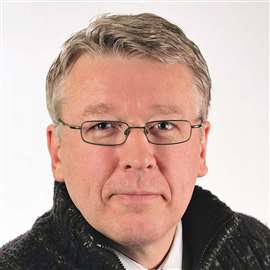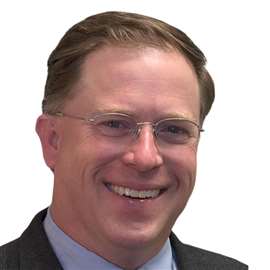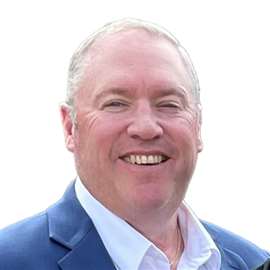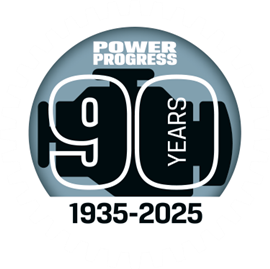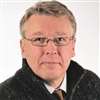Bosch Rexroth plans market rebound
20 May 2025
Executives from Bosch Rexroth are hopeful that investment in new electric power solutions will meet increasing market demand and ‘close the scissors’
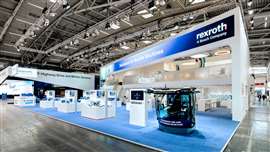 Bosch Rexroth stand at Bauma 2025 (Photo: Bosch Rexroth)
Bosch Rexroth stand at Bauma 2025 (Photo: Bosch Rexroth)
Bosch Rexroth concluded the 2024 fiscal year ‘in a very difficult market environment’. Sales of €6.5 billion were down 13.6% year-on-year. But the company is already implementing plans to revitalise itself by investing in R&D and new research facilities. There are also changes in how R&D is conducted; with greater autonomy, regional divisions can plan to deliver products tailored to the requirements of their local markets.
“As expected, 2024 was a challenging year,” said Dr. Steffen Haack, CEO. “We are currently seeing that the situation is stabilizing and are already working to prepare for a rebound in business. We are looking ahead and want to emerge rom this phase stronger than ever in order to remain successful even in a difficult environment.”
Electric future
Across the halls at Bauma 2025, the focus was on the electrification of powertrains for construction and mining machines. Bosch Rexroth was right on trend; highlights on the company stand included new 96 V motors and inverters; these additions to the eLion portfolio are intended for material handling equipment and other machines with lower power requirements.
 Steffen Mutschler, Bosch Rexroth
Steffen Mutschler, Bosch Rexroth
“Until now we have only seen local zero-emission requirements for construction sites in a few European cities, but we expect more of them to come in the future”
Asked if these new and future products would be sufficient to improve market performance, Steffen Mutschler, director of Sales and Product Management for Electrification of Mobile Machines at Bosch Rexroth had this to say: “We see several key applications in the current market environment; we see electrification is very strong for underground operations, particularly mining. We’re also seeing demand for electrification in material handling, harbour and airport equipment. The potential to eliminate emissions and reduce overall CO2 output in these sectors will move those markets towards electrification.”
Looking at the wider construction market, Mutschler said that adoption of electrified machines would be down to implementation of low- and zero-emission job sites. He underlined this with a suitably salient comment: “Until now we have only seen local zero-emission requirements for construction sites in a few European cities, but we expect more of them to come in the future.”
Of course, these adoption rates vary by region and country. For example, it has been put forward that in 2024, fully 30% of all wheel loaders sold in China were pure electric models. Mutschler says that the success of electric machines in China is down to favourable total cost of ownership (TCO) numbers.
“Basically, we see that [in China] the prices for electricity are much lower. Customers are selecting their machines based on those prices and the resulting overall TCO. There’s simply a big advantage to selling those models in a country where electric versions offer a reduced operating cost.”
European market model
There will be challenges to replicating this in Europe believes Matthias Aberle, senior vice president of Business Unit Mobile Solutions at Bosch Rexroth. To start, the cost of electricity in many countries is considerably higher than in China. Availability of charging infrastructure will also play a role.
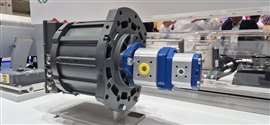 New EML 1 96 V motor for the eLion range on the Bosch Rexroth stand at Bauma (Photo: Power Progress)
New EML 1 96 V motor for the eLion range on the Bosch Rexroth stand at Bauma (Photo: Power Progress)
If this is making new machines with electric drives difficult to sell in Europe, is there an argument for introducing retrofit kits that could be installed in an originally diesel-powered machine when that engine has come to the end of its working life?
“That makes sense when your customers are looking at low volumes of these machines, if you need to react in the short-term to demand for electric machines in cities like Oslo or Amsterdam,” Aberle replied. “But it doesn’t make sense for a large OEM to tool up a high-volume assembly line to produce these machines in such low numbers. That’s why we’re seeing a lot of smaller companies now offering retrofitting services, even collaborating with OEMs to develop the best solutions.”
Government support
While the cost of buying and running electric machines in Europe are still unfavourable, it might help if governments were to support those efforts with incentives to get the industry moving in that direction. As it stands, the only incentives to using electric machines are broad emissions regulations and positive public relations.
“We need to reduce CO2 emissions across industry to benefit the environment. This is why we do what we do, improving the efficiency of our components, combining hydraulics with electric solutions to offer efficient, optimised solutions to our customers to reduce energy consumption. It’s our contribution to cutting CO2,” said Aberle.
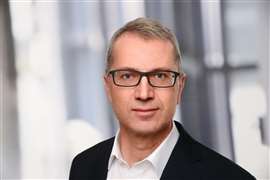 Matthias Aberle, Bosch Rexroth
Matthias Aberle, Bosch Rexroth
“Diesel engines and diesel fuel could get to a cost point where they create equivalence in TCO between conventional and electric machines”
There is a wider concern across construction – and even into the passenger car market – that it is difficult to ascertain how battery packs have been made and used, the carbon footprint and anticipated remaining operational life. However, there is EU legislation set to come into effect (from February 2027) that will make ‘battery passports’ a requirement, giving access to this and other data. Aberle believes that this will be “super important”.
“Bringing machines to a total cost level which the market will accept will be based on a number of factors, but this is one of them. A battery passport will go some way to supporting the market.
“There is also the possibility that the cost of conventional machines might increase, which would bring the TCO for the two machine types closer together. Diesel engines and diesel fuel could get to a cost point where they create equivalence in TCO between conventional and electric machines – in Germany, we say it would ‘close the scissors’.”
This information feeds into the European business model of machines having a second, possibly even a third life. It would ensure that the original buyer, and even the second or third owner of an electric machine, could recoup more of their initial investment.
Aberle: “In China there’s a different model. A machine will generally have one working life and it is done. Machines in Western Europe can move on to Eastern Europe or Africa. Electric machines have to fit within this model and knowing their condition will support that.”
POWER SOURCING GUIDE
The trusted reference and buyer’s guide for 83 years
The original “desktop search engine,” guiding nearly 10,000 users in more than 90 countries it is the primary reference for specifications and details on all the components that go into engine systems.
Visit Now
STAY CONNECTED




Receive the information you need when you need it through our world-leading magazines, newsletters and daily briefings.
CONNECT WITH THE TEAM

